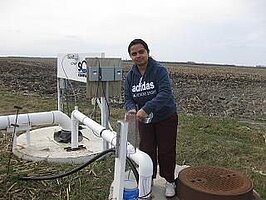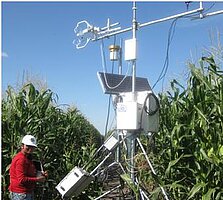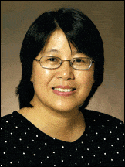Reference Evapotranspiration and Actual Evapotranspiration Measurements in ND

Ishara Rijal is a Master of Science student in the Department of Agricultural and Biosystems Engineering, North Dakota State University (NDSU). Before coming to NDSU, Rijal earned her undergraduate degree in Agricultural Engineering from Tribhuvan University, Nepal. Her present research is based on water management, crop water requirement, and irrigation to measure evapotranspiration from the tile drained and undrained portion of field to compare the atmospheric water loss from each field.
Email: ishara.rijal@ndsu.edu
Phone: 701-231-8927
Fellow: Ishara Rijal
Advisor: Xinhua Jia,Department of Agricultural and Biosystems Engineering, North Dakota State University
Matching Support: North Dakota State University.
Degree Progress: MS in Agricultural and Biosystems Engineering, expected graduation in December 2010.
Reference Evapotranspiration and Actual Evapotranspiration Measurements in ND
Evapotranspiration (ET) is one of most important components in the hydrologic cycle, and the only path for water to move from the earth surface back to the atmosphere. Almost all research related to water resources requires a good understanding on ET and/or accurate ET estimates. However, ET is most difficult to measure. In general, there are two ways to measure the ET, namely direct and indirect methods. Direct method includes lysimeters, eddy covariance (EC) system, soil water budget (SWB), mass or energy balance. Indirect methods include the calculations of reference ET through combination, temperature, and radiation methods, and a crop coefficient. Lysimeters and EC methods are the most accurate method to calculate actual ET (ETc). In ND, ETc is calculated from SWB method and was used mainly for irrigation scheduling. Using an EC system to measure ETc is not previous used in ND. The EC method measures the surface fluxes using precise and high speed instrument at a frequency of 10-20 Hz. It is superior to lysimeter and SWB approaches because it measures the ET above crop canopy and accounts for a large area. It also measures the ETc without interfering with surface different water management practices, such as elevated water table and subsurface drainage (SSD) conditions. Evapotranspiration varies with the depth of water table, higher in areas having shallow water table either through a controlled SSD, or a subsurface irrigation. ETc generally increases with the increase in consumption of water by plant, higher in the summer and lower in the spring and fall. The purpose of this study is to measure the ETc loss from fields with and without SSD, and determine the actual water requirement for soybean in the southeast of ND.
Project Objectives :
The research project will focus on the evapotranspiration measurement on undrained and subsurface drained fields. The specific objectives of the study are to:
- Evaluate the ET for both drained and undrained fields for a soybean field in the southeast corner of the state using the EC system.
- Compare different ET calculations for the same field using the eddy covariance and soil water balance methods
- Compare the reference ET estimated by the ASCE-EWRI (2005), the Jensen-Haise (1963) and the ETgage.
Progress:
The SSD system was installed in 2002 by the landowner. Twenty four piezometers were installed in the fall 2007. Water level loggers were installed in each piezometer during the growing season 2009. Two weather stations, equipped with complete eddy covariance systems, have been set up in the drained and undrained part of field. Six pairs of soil moisture sensor have been installed in each site at six different depths. ETgage was also placed in all three sites. It was observed that during early summer, the ETc was higher in the undrained portion of the field while in fall and late summer, the ETc was higher in the drained portion. Overall, the ETc was found higher in the undrained part of the field by 11%. Water table in the undrained field was found lower during late summer and early fall. Some temporary rise in water table and moisture content was observed following rainfall events.
Research Outcomes:
Ishara Rijal, Xiao Pang, and Xinhua Jia. 2009. Soil moisture distributions for subsurface drainage and subirrigation soils. 2009 ASABE/CSBE North Central Intersectional Conference, September 18-19, 2009. Brookings, SD.(oral presentation)
Ishara Rijal, X. Jia, D. D. Steele, T. Scherer, X. Zhang, and X. Pang. 2009. Comparison of reference and actual evapotranspiration in North Dakota (ND). ASABE 2010 Annual International Meeting, June 20-23, 2010, Pittsburg, PA. (Abstract)
Significance:
Evapotranspiration is one of the most important components in the water balance. The results will help to answer “where does the water go” by determining the water balance for each field, and to evaluate the impact of the SSD on the water quantity. Estimation of evapotranspiration from SSD and regular field will facilitate in arranging crop water requirement, determine the water balance, and improve our overall understanding in hydrology.


Xinhua Jia, P.E., Professor
Morrill Hall Room 204
Department of Agricultural and Biosystems Engineering
North Dakota State University
NDSU Dept. 7620PO Box 6050
Fargo ND 58108-6050
Phone: (701) 231-6453
E-mail: xinhua.jia@ndsu.edu


